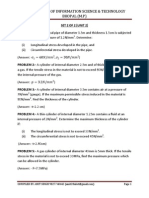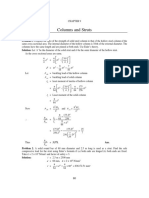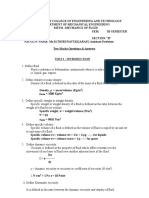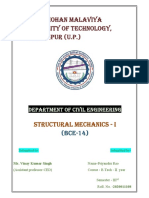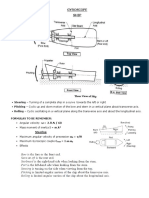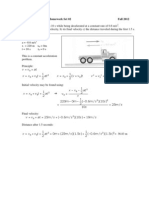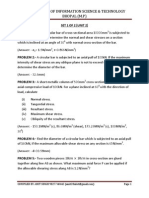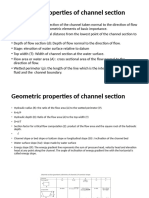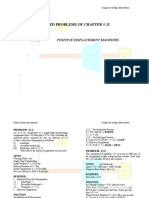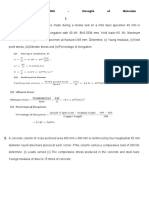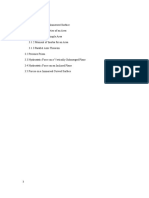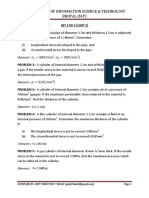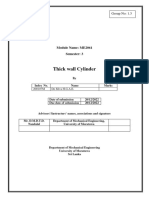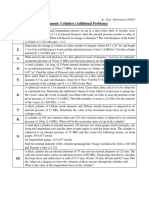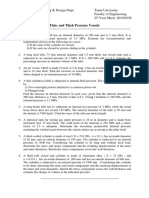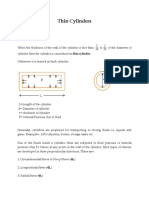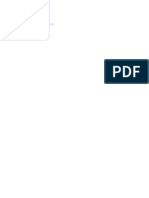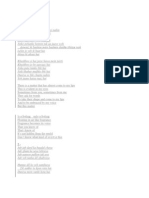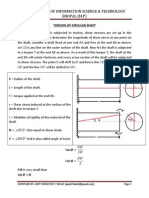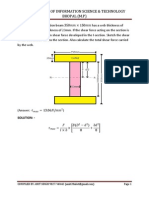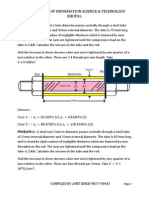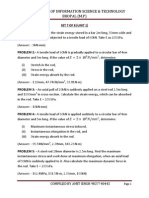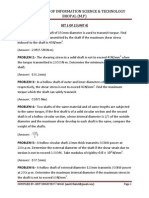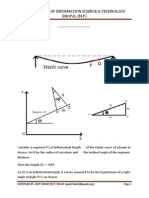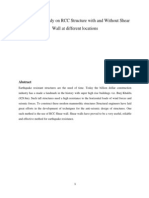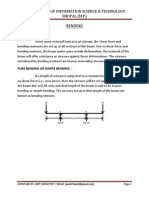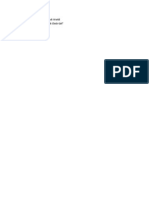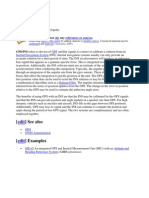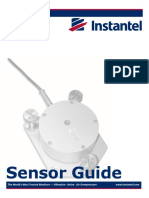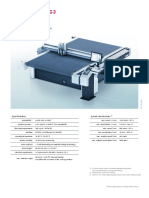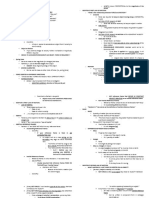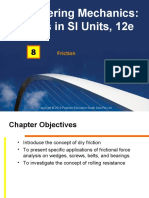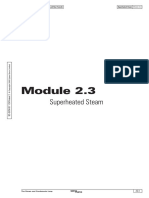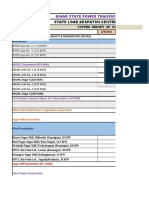NRI INSTITUTE OF INFORMATION SCIENCE & TECHNOLOGY BHOPAL (M.
P)
PROBLEM 23:- A thin cylindrical tube 80mm internal diameter and 5mm thick, is closed at the ends and is subjected to an internal pressure of 6N/mm2. A torque of 2009600Nmm is also applied to the tube. Find the hoop stress, longitudinal stress; maximum and minimum principal stresses and maximum shear stress. Answer: (i) (ii) (iii) (iv) (v) Hoop stress=48N/mm2 Longitudinal stress=24N/mm2 Max principal stress=77.7N/mm2 (tensile) Minimum principal stress=-5.76N/mm2 (compressive) Maximum shear stress=41.76N/mm2
SOLUTION: (i) Hoop stress
(ii)
Longitudinal stress
(iii)
Maximum and minimum principal stress
The stress 1 and 2 are tensile stresses. But the cylindrical tube is also subjected to torque. Due to torque, shear stress will be produced in the tube. As the thickness of the wall of the tube is small, the shear stress is assumed to be uniform through out the thickness Hint: -
COMPILED BY AMIT SINGH 9827740442 (amit28niist@gmail.com)
Page 1
�NRI INSTITUTE OF INFORMATION SCIENCE & TECHNOLOGY BHOPAL (M.P)
But torque applied = 2009600Nmm Equating the two value of torque we get
Hence material of the tube is subjected two tensile stresses , and accompanied by a shear stress maximum principal stress is given by ( )
so
COMPILED BY AMIT SINGH 9827740442 (amit28niist@gmail.com)
Page 2
�NRI INSTITUTE OF INFORMATION SCIENCE & TECHNOLOGY BHOPAL (M.P)
PROBLEM 24:- A copper cylinder, 90 cm long, 40cm external diameter and wall thickness 6mm has its both ends closed by rigid blank flanges. It is initially full of oil at atmospheric pressure. Calculate the additional volume of oil which must be pumped into it in order to raise the oil pressure to 5N/mm2 above atmospheric pressure. For copper assume And Poissons ratio, =1/3. Take bulk modulus of oil as 2.6 . (Answer: SOLUTION: Hint: )
Length of cylinder, L=90cm External diameter, D=40cm Wall thickness, t=6mm Internal diameter, d=External diameter - 2 * wall thickness=388mm Initial Volume of oil, V=Internal volume of cylinder
COMPILED BY AMIT SINGH 9827740442 (amit28niist@gmail.com) Page 3
�NRI INSTITUTE OF INFORMATION SCIENCE & TECHNOLOGY BHOPAL (M.P)
Due to internal pressure of fluid inside the cylinder, there will be a change in the dimensions of the cylinder. Due to this, there will be a increase in the volume of the cylinder. Let us first calculate this increase in volume of the cylinder.
As the bulk modulus of oil is given, then due to increase of fluid pressure on the oil, the original volume of oil decrease. Let us find this decrease in volume of oil.
Resultant additional space created in the cylinder= Increase in volume of cylinder + Decrease in volume of oil
PROBLEM 26:- A cylindrical water tank of height 25m, inside diameter 2.2m, having vertical axis is open at the top. The tank is made of steel having yield stress of 210MN/m2. Determine the thickness of steel used when the tank is full of water. Efficiency of the longitudinal joint=70%, factor of safety=3
COMPILED BY AMIT SINGH 9827740442 (amit28niist@gmail.com) Page 4
�NRI INSTITUTE OF INFORMATION SCIENCE & TECHNOLOGY BHOPAL (M.P)
(Answer: - 6mm) SOLUTION: -
The pressure will be maximum at the base. The pressure must be resisted by steel sheet and therefore the thickness must be determined by taking pressure into consideration. Pressure at the base = wh Take w = 10kN/m3
Since the tank is open at the top, there will only be hoop (or circumferential stress) stress which at under any circumstances, should not exceed the working stress.
PROBLEM 48: - A steel tube having a bore of 150mm, wall thickness 2.25mm is plugged at each end to form a closed cylinder with external length of 450mm. If
COMPILED BY AMIT SINGH 9827740442 (amit28niist@gmail.com)
Page 5
�NRI INSTITUTE OF INFORMATION SCIENCE & TECHNOLOGY BHOPAL (M.P)
the tube is filled with oil and is subjected to a compressive load of 90kN determine: (i) (ii) The pressure produced on oil. The resulting circumferential stress in the tube wall.
Given for oil: K (bulk modulus) = 2800MN/m2; For steel: E = 210GN/m2, and Poissons ratio = 0.28 (Answer: -0.267MN/m2, 8.9MN/m2) SOLUTION: -
(i)
The pressure produced on oil, p
Let, For equilibrium we have,
COMPILED BY AMIT SINGH 9827740442 (amit28niist@gmail.com)
Page 6
�NRI INSTITUTE OF INFORMATION SCIENCE & TECHNOLOGY BHOPAL (M.P)
Now bulk modulus of the oil
Since in this case
is negative
From the above two equation we get
COMPILED BY AMIT SINGH 9827740442 (amit28niist@gmail.com)
Page 7
�NRI INSTITUTE OF INFORMATION SCIENCE & TECHNOLOGY BHOPAL (M.P)
(ii)
Circumferential stress
PROBLEM 49: - The ends of a thin cylinder, 180mm internal diameter and wall thickness 3.0mm are closed by rigid plates and it is then filled with a liquid. When an axial compressive force of 33.6kN is applied to the cylinder, the pressure of the liquid rises by 72kN/m2. If E = 200GN/m2 and Poissons ratio = 0.3, find the bulk modulus of the liquid. (Answer: - K = 3.75GN/m2) SOLUTION: As no liquid is pumped in or is allowed to escape, therefore, volumetric strain of the liquid = compressive volumetric strain of the shell. Thus if P be the axial force on the shell which raises the pressure of liquid to p, then
COMPILED BY AMIT SINGH 9827740442 (amit28niist@gmail.com)
Page 8
�NRI INSTITUTE OF INFORMATION SCIENCE & TECHNOLOGY BHOPAL (M.P)
But compressive volumetric strain of the liquid
Where K is in GN/m2
COMPILED BY AMIT SINGH 9827740442 (amit28niist@gmail.com) Page 9
�NRI INSTITUTE OF INFORMATION SCIENCE & TECHNOLOGY BHOPAL (M.P)
PROBLEM 50: - A cylinder made of brass 180mm outside diameter and 15mm thick is strengthened by a single layer of steel wire 2.25mm diameter wound over it under a constant stress of 75MN/m2. The cylinder is subjected to an internal pressure of 27MN/m2, with rise in temperature of the cylinder by 1200C. Assuming the cylinder to be a thin shell with closed ends, determine the final value of: (i) (ii) (iii) Take: For steel: For brass: Poissons ratio = 0.32 (Answer: - 415MN/m2 (t), 86.62MN/m2 (t), 8.06MN/m2) SOLUTION: (i) Stress in the wire The stress in the wire. The circumferential stress in the cylinder wall. The radial pressure between the wire and the cylinder.
(a) Before subjecting the cylinder to internal pressure: Tensile force exerted by wire per unit length = Compressive force developed in the cylinder ( )
Page 10
COMPILED BY AMIT SINGH 9827740442 (amit28niist@gmail.com)
�NRI INSTITUTE OF INFORMATION SCIENCE & TECHNOLOGY BHOPAL (M.P)
( ( ) )
(b) After subjecting the cylinder to internal pressure Due to the internal pressure, the longitudinal stress developed in the cylinder Total bursting force = Total resisting force (per unit length) ( ( ) )
COMPILED BY AMIT SINGH 9827740442 (amit28niist@gmail.com)
Page 11
�NRI INSTITUTE OF INFORMATION SCIENCE & TECHNOLOGY BHOPAL (M.P)
Equating the strains in cylinder and wire, we have
Substituting the value of
in equation (i) we get
Final stress in the wire = w + w = 75 + 339.45 = 415MN/m2 (t)
(ii)
The circumferential stress in the cylinder wall
Final circumferential stress in the cylinder wall
COMPILED BY AMIT SINGH 9827740442 (amit28niist@gmail.com) Page 12
�NRI INSTITUTE OF INFORMATION SCIENCE & TECHNOLOGY BHOPAL (M.P)
= c + c = -8.84 + 95.46 = 86.62MN/m2 (t) (iii) The radial pressure between the wire winding and temperature rise.
Final circumferential stress =
COMPILED BY AMIT SINGH 9827740442 (amit28niist@gmail.com)
Page 13
